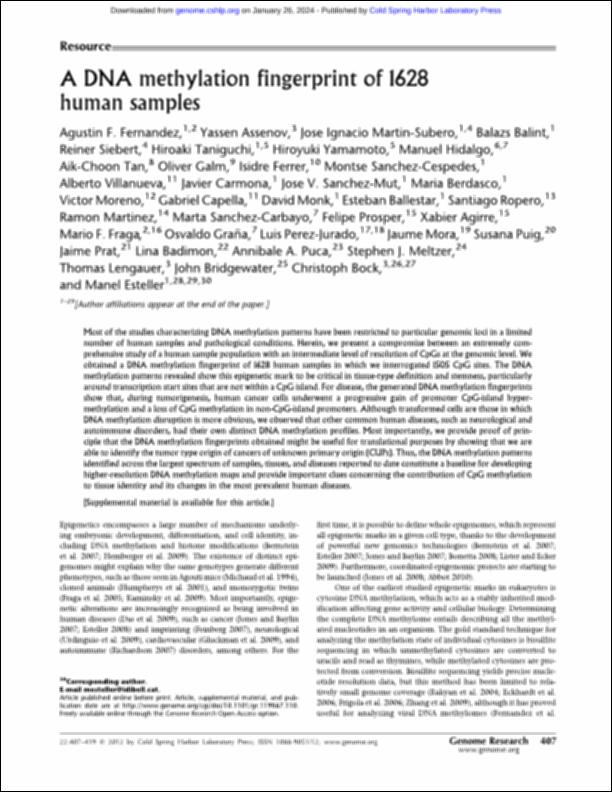Por favor, use este identificador para citar o enlazar este ítem:
http://hdl.handle.net/10637/15256A DNA methylation fingerprint of 1628 human samples
| Título : | A DNA methylation fingerprint of 1628 human samples |
| Autor : | Fernández, Agustín F. Assenov, Yassen Martín Subero, José Ignacio Balint, Balazs Siebert, Reiner Taniguchi, Hiroaki Yamamoto, Hiroyuki Hidalgo Medina, Manuel Tan, Aik-Choon Galm, Oliver Ferrer Abizanda, Isidre Sánchez Céspedes, Montse Villanueva, Alberto Carmona, Javier Sánchez-Mut, José V. Berdasco, Maria Moreno, Victor Capella, Gabriel Monk, David Ballestar, Esteban Ropero, Santiago Martínez, Ramón Sánchez-Carbayo, Marta Prósper Cardoso, Felipe Agirre, Xabier Fraga, Mario F. Graña, Osvaldo Pérez-Jurado, Luis Mora, Jaume Puig, Susana Prat, Jaime Badimón, Lina Puca, Annibale A. Meltzer, Stephen J. Lengauer, Thomas Bridgewater, John Bock, Christoph Esteller, Manel |
| Materias: | Cell line; DNA methylation; Cluster analysis; Epigenomics |
| Editorial : | Cold Spring Harbor Laboratory Press |
| Citación : | Fernandez AF, Assenov Y, Martin-Subero JI, Balint B, Siebert R, Taniguchi H, Yamamoto H, Hidalgo M, Tan AC, Galm O, Ferrer I, Sanchez-Cespedes M, Villanueva A, Carmona J, Sanchez-Mut JV, Berdasco M, Moreno V, Capella G, Monk D, Ballestar E, Ropero S, Martinez R, Sanchez-Carbayo M, Prosper F, Agirre X, Fraga MF, Graña O, Perez-Jurado L, Mora J, Puig S, Prat J, Badimon L, Puca AA, Meltzer SJ, Lengauer T, Bridgewater J, Bock C, Esteller M. A DNA methylation fingerprint of 1628 human samples. Genome Res. 2012 Feb;22(2):407-19. doi: 10.1101/gr.119867.110. Epub 2011 May 25. PMID: 21613409; PMCID: PMC3266047 |
| Resumen : | Most of the studies characterizing DNA methylation patterns have been restricted to particular genomic loci in a limited number of human samples and pathological conditions. Herein, we present a compromise between an extremely comprehensive study of a human sample population with an intermediate level of resolution of CpGs at the genomic level. We obtained a DNA methylation fingerprint of 1628 human samples in which we interrogated 1505 CpG sites. The DNA methylation patterns revealed show this epigenetic mark to be critical in tissue-type definition and stemness, particularly around transcription start sites that are not within a CpG island. For disease, the generated DNA methylation fingerprints show that, during tumorigenesis, human cancer cells underwent a progressive gain of promoter CpG-island hypermethylation and a loss of CpG methylation in non-CpG-island promoters. Although transformed cells are those in which DNA methylation disruption is more obvious, we observed that other common human diseases, such as neurological and autoimmune disorders, had their own distinct DNA methylation profiles. Most importantly, we provide proof of principle that the DNA methylation fingerprints obtained might be useful for translational purposes by showing that we are able to identify the tumor type origin of cancers of unknown primary origin (CUPs). Thus, the DNA methylation patterns identified across the largest spectrum of samples, tissues, and diseases reported to date constitute a baseline for developing higher-resolution DNA methylation maps and provide important clues concerning the contribution of CpG methylation to tissue identity and its changes in the most prevalent human diseases. |
| URI : | http://hdl.handle.net/10637/15256 |
| Derechos: | http://creativecommons.org/licenses/by-nc-nd/4.0/deed.es |
| ISSN : | 1549-5469 |
| Fecha de publicación : | 25-may-2011 |
| Centro : | Universidad San Pablo-CEU |
| Aparece en las colecciones: | Medicina |
Los ítems de DSpace están protegidos por copyright, con todos los derechos reservados, a menos que se indique lo contrario.


